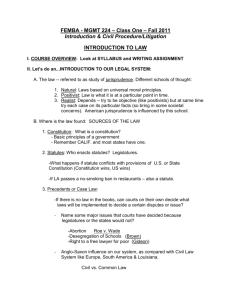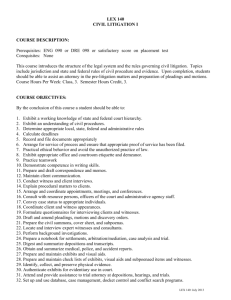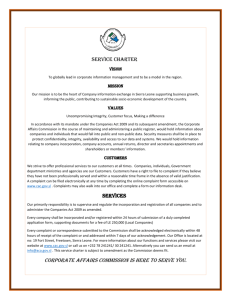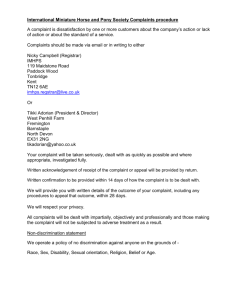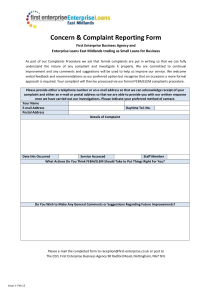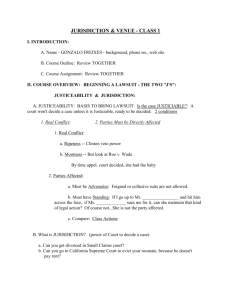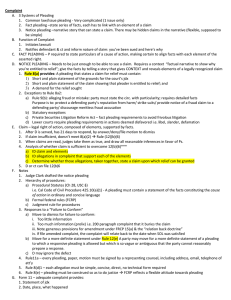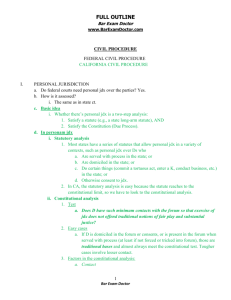Civil_Procedure
advertisement
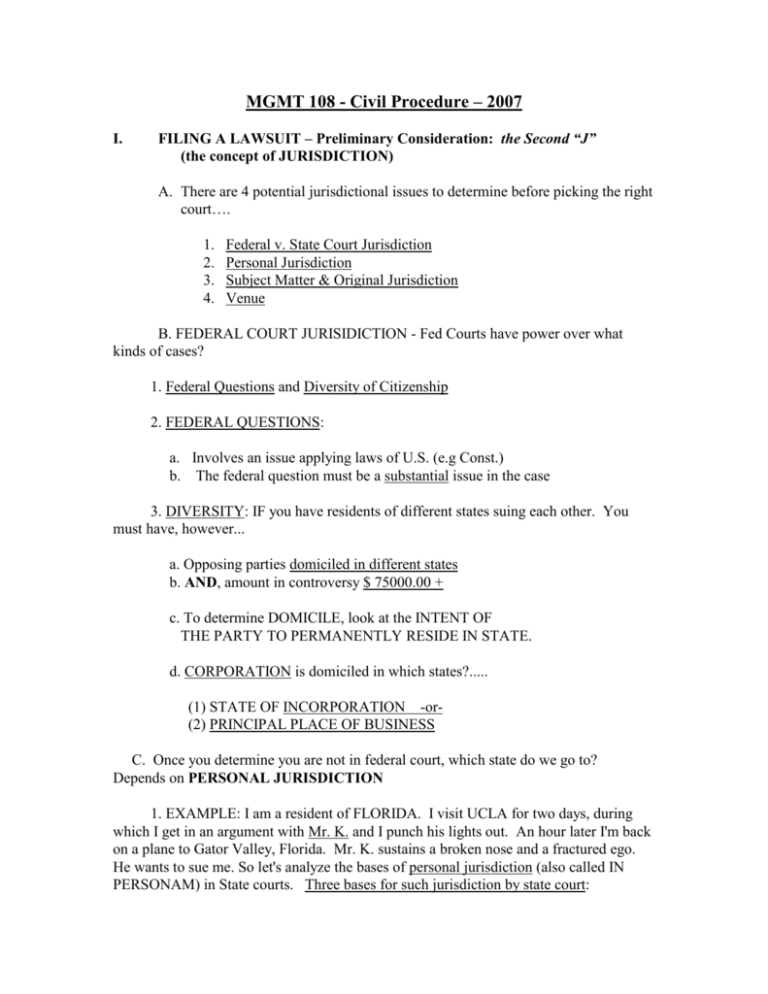
MGMT 108 - Civil Procedure – 2007 I. FILING A LAWSUIT – Preliminary Consideration: the Second “J” (the concept of JURISDICTION) A. There are 4 potential jurisdictional issues to determine before picking the right court…. 1. 2. 3. 4. Federal v. State Court Jurisdiction Personal Jurisdiction Subject Matter & Original Jurisdiction Venue B. FEDERAL COURT JURISIDICTION - Fed Courts have power over what kinds of cases? 1. Federal Questions and Diversity of Citizenship 2. FEDERAL QUESTIONS: a. Involves an issue applying laws of U.S. (e.g Const.) b. The federal question must be a substantial issue in the case 3. DIVERSITY: IF you have residents of different states suing each other. You must have, however... a. Opposing parties domiciled in different states b. AND, amount in controversy $ 75000.00 + c. To determine DOMICILE, look at the INTENT OF THE PARTY TO PERMANENTLY RESIDE IN STATE. d. CORPORATION is domiciled in which states?..... (1) STATE OF INCORPORATION -or(2) PRINCIPAL PLACE OF BUSINESS C. Once you determine you are not in federal court, which state do we go to? Depends on PERSONAL JURISDICTION 1. EXAMPLE: I am a resident of FLORIDA. I visit UCLA for two days, during which I get in an argument with Mr. K. and I punch his lights out. An hour later I'm back on a plane to Gator Valley, Florida. Mr. K. sustains a broken nose and a fractured ego. He wants to sue me. So let's analyze the bases of personal jurisdiction (also called IN PERSONAM) in State courts. Three bases for such jurisdiction by state court: a. Presence of D.: If the D. is present in the state we nail him, unless... --- A witness ---- By force b. Domicile of D.: c. Consent of D.: (1) Express: I get Mr. K.’s lawsuit in the mail, and I show up in court and answer. Called the stupid defendant rule. Or we agree to state court jdx. Ahead of time in a written contract clause. (2) Implied Consent: LONG ARM STATUTE: Get's sticky ---- by engaging in activities in the state (e.g. COMING HERE AND PUNCHING HIS LIGHTS OUT). I should know that punching someone's lights out in California might cause me to have to pay the consequences. WHAT IS A LONG-ARM STATUTE? Think of a long arm reaching across U.S. to pluck me out of Florida. Usually 2 types of activities will result in “Minimum Contacts” that the courts require to exercise personal jdx…. (a) Business: Transaction of any business in state (b) Injury: Commission of any act causing injury in state MINIMUM CONTACTS: Well, as you might imagine, these LONG ARM STATUTES that states were passing, were getting out of hand. So US Supreme Court came along and said, WAIT A MINUTE, there is this thing called the CONSTITUTION. And it has a clause that guarantees individuals DUE PROCESS. So Long Arm Statutes can't abuse their power and jurisdiction must be exercised REASONABLY. The test they set up is MINIMUM CONTACTS. INTERNET CASES: If user can order products online, then Jdx. exists in the buyer’s home state. 2. An ALTERNATIVE option to In Personam Jdx.: Property in the State: a. Distinguish --- The previous 4 are considered what kind of jurisdiction? -----IN PERSONAM Jdx. (over the person) b. Also, can exercise jdx. if D. owns property in the state, what is this called? --IN REM Jdx. c. If court has In Rem Jdx. can they order the Defendant to do something personally? [NO CAN ONLY AFFECT HIS PROPERTY] D. SUBJECT MATTER JURISDICITON: States will not get involved in certain disputes even if personal jurisdiction OK. 1. Depends on the subject of the lawsuit. E.g. Could FLORIDA D.A. charge me with Criminal Assault and Battery in FLORIDA Court? NO (Criminal case must be heard where crime occurred) ----Other examples - - - divorce, probate tax laws, must go to those courts. 2. Original Jdx.: Book refers to this as part of Subject Matter Jdx. Has to do with which court you go to based on the amount in controversy in the lawsuit. In California… a. Small Claims: $0-$7500 b. Municipal (Now called “Superior Court of Limited Jurisdiction: 0-$25,000 c. Superior Court of General Jurisdiction: > $25,000, family law, probate, juvenile, mental health, Felonies (>1 year) E. VENUE - Once we have determined which Judicial System (State or Federal), & we know which Court of Original Jdx. (e.g. Municipal), what is the final choice we have to make about what court to file our lawsuit??? : VENUE 1. What is VENUE? ---Choice of territorial division/geographic location court. 2. Federal: Districts -- L.A.- Central S.D. - Southern S.F. - Northern 3. State: California a. County: LA, Orange, Ventura, etc. b. District: Superior Court: Central and then Branch Courts Municipal: Many small Branch courts --from Malibu, to Catalina 4. Usual Requirements of Venue: a. Residency: Usually of Deft. b. Where Claim Arose: Where acct. happened, where contract was signed, where business was transacted c. Corporation: Anywhere doing business. OK - LET'S REVIEW THIS WHOLE ISSUE OF JURISDICTION 1. What is jurisdiction? power to decide a case 5-prong question: a. Federal or State System b. In Personnam or Rem c. Subject Matter d. Original e. Venue *********************************************************** ---ALL RIGHT, SO WE'VE EXHAUSTED JDX. NOW WE ARE READY TO FILE OUR LAWSUIT. WHAT DO WE DO???? II. FOUR POTENTIAL STAGES OF LITIGATION… A. B. C. D. Pleadings Pre-Trial Trial Appeal III. PLEADINGS: What are pleadings? (Formal written statements of parties) A. Let's List them -- What are the pleadings that are filed in a lawsuit: P D D P D or P 1. Complaint (and Summons) 2. Answer 3. Cross-Claims: a. Federal: Counterclaim b. State: Cross Complaint 4. Answer or Reply: 5. Amendments to Pleadings: B. SUMMONS & COMPLAINT: 1. What is the difference between Summons & Complaint ---S= Notice of Suit ---C=Content of Suit (Causes) 2. SUMMONS: Most provide 20 or 30 days to respond (compare w/ UD= 5 days) 3. Statute of Limitations: What is it? Injury claims - 1 year Contract - 2 or 4 yrs. 4. Complaint: Contains three things: Fraud - 3 yrs. a. Caption: ID Parties, Court, etc. b. Causes of Action c. Remedy or Prayer: 1. Equity Something else 2. Law: Money 5. Service of the Summons/Complaint: Must be given to Defendant a. Personal: b. Substituted c. Publication d. What about registered mail: NO GOOD for in state resident C. ANSWER: Contains a. Admissions - denials b. Affirmative Defenses - legal excuses to complaint D. CROSS CLAIMS: Deft. counterclaims or cross-complaints: a. Compulsory: Related to facts in Complaint–can’t sue later in another suit. b. Permissive: Same parties, but unrelated to facts in complaint, can sue now in cross complaint or wait to sue later in a separate suit. E. MOTION: What is it are NOT pleadings. (Application for a court order) NOTE: These motions a. Possible responsive motions: 1. Motion to Dismiss (Federal) 2. State (California): (a)Demurrer – attacks the complaint as a whole. “even if complaint is true” this claim still does not state a legal case. (b)Motion to Strike: Strikes out a portion of the complaint that is defective. F. AMENDMENTS: Making a change in your pleading. 1. Once as a matter of course. 2. After that by court motion. IV. PRE-TRIAL PROCEEDINGS: A. Purpose of Pre-Trial Proceedings: 1. Discovery of Relevant Facts 2. Narrowing Issues 3. Promote Settlement B. DISCOVERY: What is it? What are the types of Discovery? 1. Interrogatories – written questions 2. Requests for Admissions – asks a party to admit or deny facts 3. Depositions – In person questioning of witness or party. Used to… a. ---Learn testimony of party/wit. for trial b. ---Judge Credibility 4. Production of Documents – asks to see documents or other items. C. PRE-TRIAL HEARINGS: 1. Status or Settlement Conferences: 2. Arbitration/Mediation 3. Motions: a. Sometimes used to Narrow Issues without trial: (1) Motion for Judgment on the Pleadings: Even if we accept everything in the complaint or answer as true, still no case. Cannot consider any facts OUTSIDE of Complaint and Answer. (2) SUMMARY JUDGEMENT Like a mini trial on paper. To overcome, only requires a showing that dispute exists. Anything can be attached to Motion for court to consider: witness statements, documents, pictures, interrogatories, deposition testimony, etc. ---- Will be granted if “no triable issues of fact or law” exist.. V. TRIAL: A. Jury or Non-Jury: IF EITHER SIDES REQUESTS !! 1. Criminal = almost always ----Nevertheless JURY = FACTS JUDGE = LAW 1. VOIR DIRE: 2. CHALLENGES: a. For Cause b. Peremptory B. Opening Statements C. Presentation of Evidence: Witnesses & Documentary evidence. 1. Plantiff's Case in chief 2. Defendant's case in chief 3. Rebuttal 4. Rejoinder D. Closing Argument (sometimes called Summation) E. Jury Instructions F. Jury Deliberation G. Verdict H . Motions: WHAT ARE SOME OF THE TRIAL MOTIONS 1. Mistrial - Jury is unduly biased by some action of lawyers. 2. Directed Verdict (After either party rests, usually by Plff) If nothing for jury to decide. Law and facts mandate the moving party win. 3. Judgment NOV NON OBSTANTE VERIDICTO - Notwithstanding the verdict. Comes AFTER jury verdict, if verdict not based on fact or law. 4. New Trial - New evidence or judge made error in law VI. JUDGMENT AND APPEAL: A. Courts: Federal Level: Courts of Appeal United States Supreme State Level: Courts of Appeal State Supreme Court U.S. Supreme Ct. What about Small Claims or Muni Ct. -- SUPERIOR COURT B. What will Appellate Court Do: 1. Affirm 2. Reverse & Remand 3. Modify 4. They do not hear evidence. Decide issues of law unless verdict not supported by any of the evidence. C. Doctrine of RES JUDICATA (like Double Jeopardy in criminal cases) - Losing party may not refile the same action. 2nd action barred by Res Judicata (the thing has been decided).
